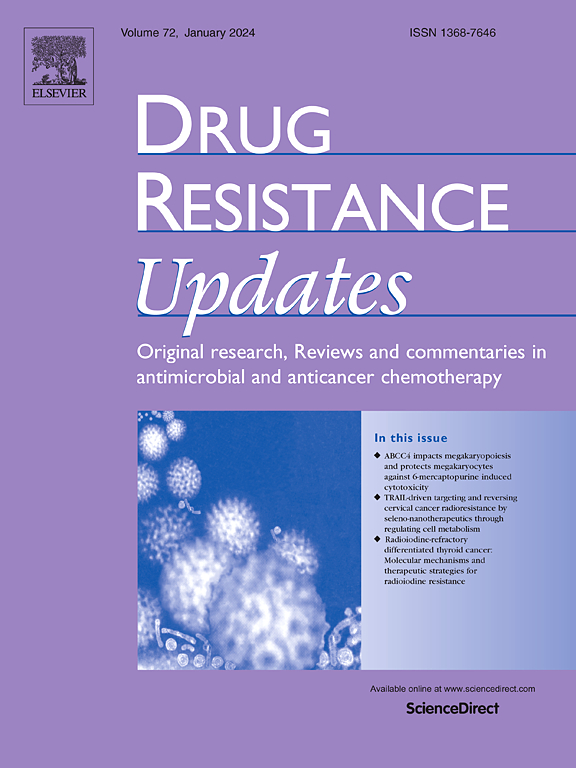金黄色葡萄球菌操纵骨细胞通过焦亡途径抑制引起持续性慢性骨髓炎和抗生素耐药性
IF 21.7
1区 医学
Q1 PHARMACOLOGY & PHARMACY
引用次数: 0
摘要
目的在慢性骨髓炎中,皮质骨是金黄色葡萄球菌(S. aureus)长期存在的主要部位,本研究旨在探讨其免疫逃避和抗生素耐药的机制尚不完全清楚。方法收集临床耐甲氧西林金黄色葡萄球菌(MRSA)分离株进行分析。实时荧光定量PCR检测Panton-Valentine leukocidin (PVL)的表达水平。通过感染骨细胞、检测caspase-1激活和IL-1β释放来评估PVL对骨凋亡的影响。通过TRAP染色和显微ct检查破骨细胞发生和病理骨形成。为了评估治疗潜力,采用4,4 ' -二甲氧基-5,6,5 ',6 ' -二亚甲基二氧联苯-2,2 ' -二磺酸二钠(DMB)诱导焦亡,然后评估骨髓炎模型的抗生素疗效和骨重塑。结果我们在临床病例中观察到,MRSA小菌落变异(scv)在皮质骨中的存活率高于非scv菌株,scv通过降低代谢活性表现出特征性的抗生素耐药性。PCR结果显示,与野生型相比,MRSA scv的PVL表达水平显著降低,这种低PVL表达表型明显抑制感染后焦亡途径的激活。此外,我们发现在适应皮质内环境的过程中,全局调节因子Sae和蛋白酶aureolyysin介导PVL的活性下调,从而导致骨细胞焦亡的靶向抑制。骨细胞焦亡的抑制同时减少宿主免疫反应、MRSA定植和抗生素耐药性。DMB药物诱导焦亡可显著提高抗生素疗效,减轻慢性骨髓炎病理性骨形成。结论smrsa通过调节自身的毒力因子,为其在骨皮质内的长期生存创造了有利的空间和环境,针对骨细胞焦亡的治疗策略可能是一种从骨皮质中根除MRSA的潜在策略。本文章由计算机程序翻译,如有差异,请以英文原文为准。
Staphylococcus aureus manipulates osteocytes to cause persistent chronic osteomyelitis and antibiotic resistance via pyroptosis pathway suppression
Aims
In chronic osteomyelitis, the cortical bone serves as the primary site for long-term persistence of Staphylococcus aureus (S. aureus), the present study aimed to explore the mechanisms of immune evasion and antibiotic resistance remain incompletely understood.
Methods
Clinical methicillin-resistant S. aureus (MRSA) isolates, were collected and analyzed. Panton-Valentine leukocidin (PVL) expression levels were quantified via real-time PCR. The impact of PVL on pyroptosis was evaluated by infecting osteocytes and measuring caspase-1 activation and IL-1β release. Osteoclastogenesis and pathological bone formation were examined through TRAP staining and micro-CT. To assess therapeutic potential, pyroptosis was pharmacologically induced using disodium 4,4’-dimethoxy-5,6,5’,6’-dimethylene dioxybiphenyl-2,2’-disulfonate (DMB), followed by evaluation of antibiotic efficacy and bone remodeling in osteomyelitis model.
Results
We observed in clinical cases that the survival rate of MRSA small colony variants (SCVs) in cortical bone is higher than that of non-SCV strains, with SCVs demonstrating characteristic antibiotic resistance through reduced metabolic activity. The PCR results demonstrated that compared to wild-type, MRSA SCVs exhibited significantly reduced expression levels of PVL, this low-PVL-expression phenotype markedly suppresses the activation of the pyroptosis pathway following infection. Furthermore, we discovered that during the adaptation to the intra-cortical environment, the global regulatory factor Sae and the protease aureolysin mediate the active downregulation of PVL, which resulted in targeted inhibition of osteocyte pyroptosis. The suppression of osteocyte pyroptosis simultaneously diminishes the host immune response, MRSA colonization, and antibiotics resistance. Pharmacological induction of pyroptosis via DMB significantly enhanced antibiotic efficacy, as well as alleviated pathological bone formation in chronic osteomyelitis.
Conclusions
MRSA modulates its own virulence factors to create a favorable space and environment for long-term survival within the cortical bone, and therapeutic strategies targeting osteocyte pyroptosis may represent a potential strategy of eradicating MRSA from cortical bone.
求助全文
通过发布文献求助,成功后即可免费获取论文全文。
去求助
来源期刊

Drug Resistance Updates
医学-药学
CiteScore
26.20
自引率
11.90%
发文量
32
审稿时长
29 days
期刊介绍:
Drug Resistance Updates serves as a platform for publishing original research, commentary, and expert reviews on significant advancements in drug resistance related to infectious diseases and cancer. It encompasses diverse disciplines such as molecular biology, biochemistry, cell biology, pharmacology, microbiology, preclinical therapeutics, oncology, and clinical medicine. The journal addresses both basic research and clinical aspects of drug resistance, providing insights into novel drugs and strategies to overcome resistance. Original research articles are welcomed, and review articles are authored by leaders in the field by invitation.
Articles are written by leaders in the field, in response to an invitation from the Editors, and are peer-reviewed prior to publication. Articles are clear, readable, and up-to-date, suitable for a multidisciplinary readership and include schematic diagrams and other illustrations conveying the major points of the article. The goal is to highlight recent areas of growth and put them in perspective.
*Expert reviews in clinical and basic drug resistance research in oncology and infectious disease
*Describes emerging technologies and therapies, particularly those that overcome drug resistance
*Emphasises common themes in microbial and cancer research
 求助内容:
求助内容: 应助结果提醒方式:
应助结果提醒方式:


